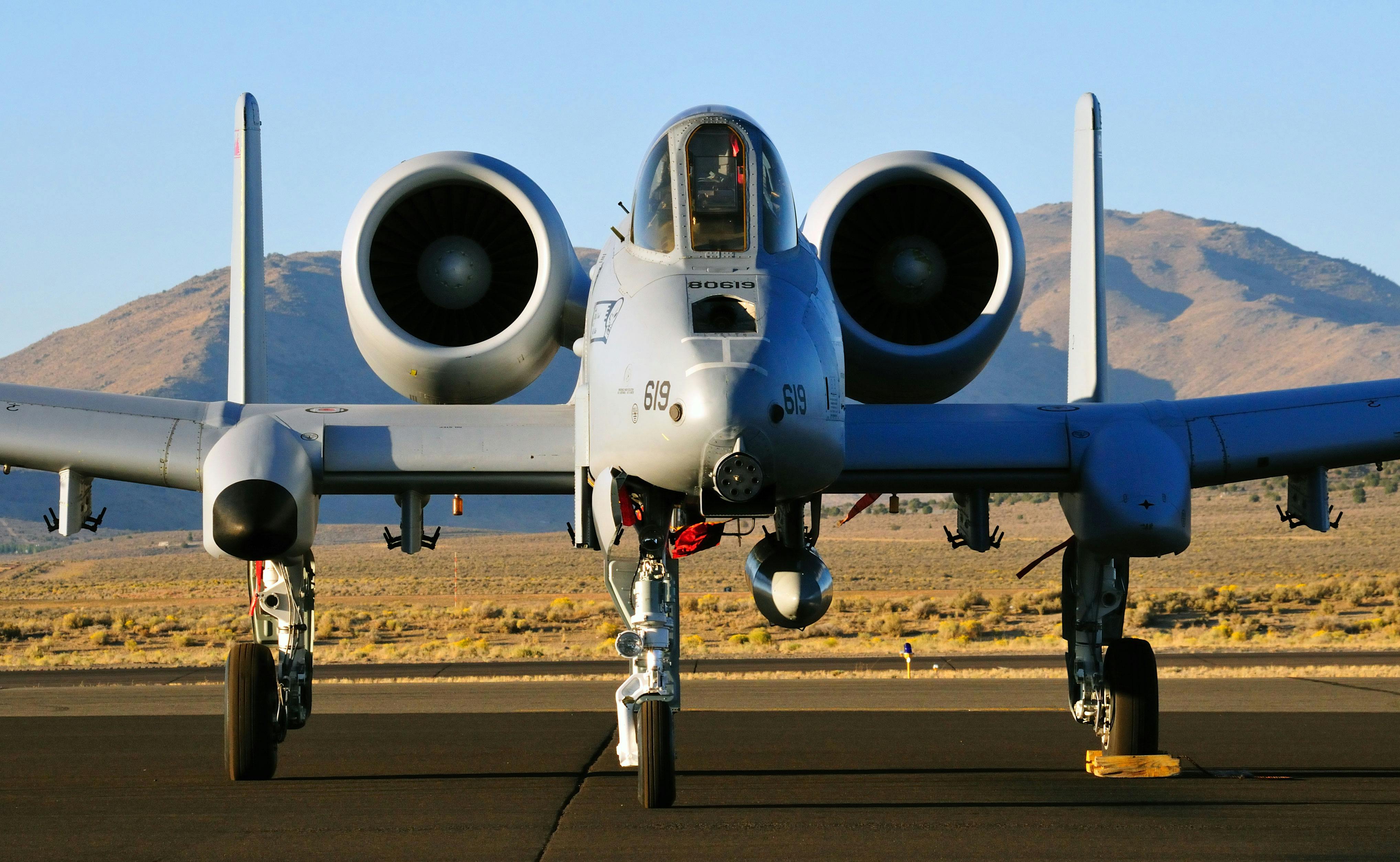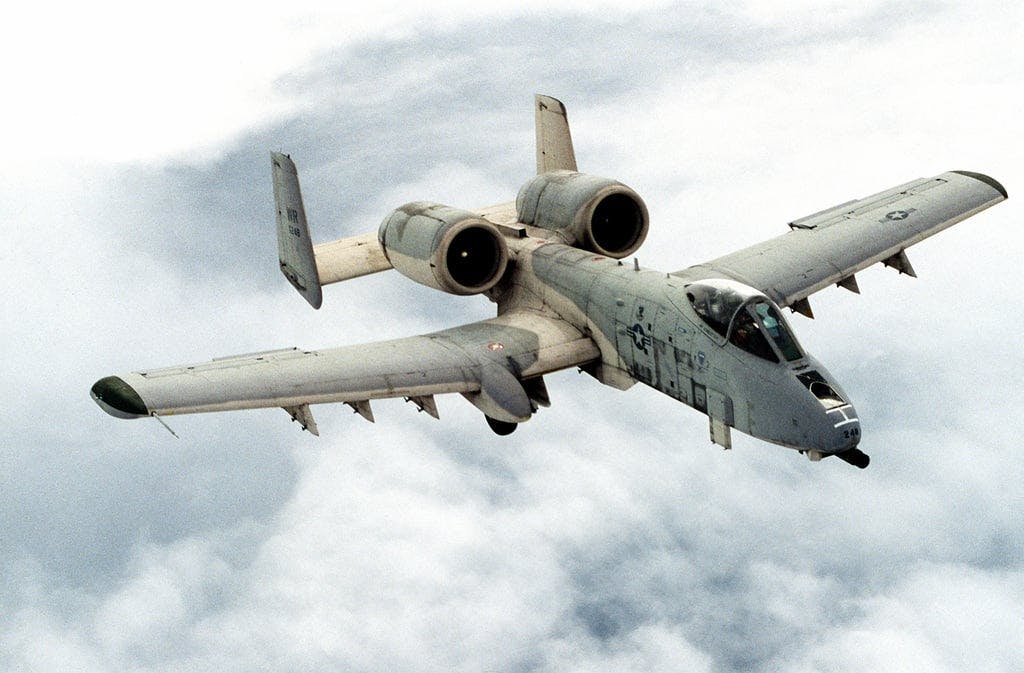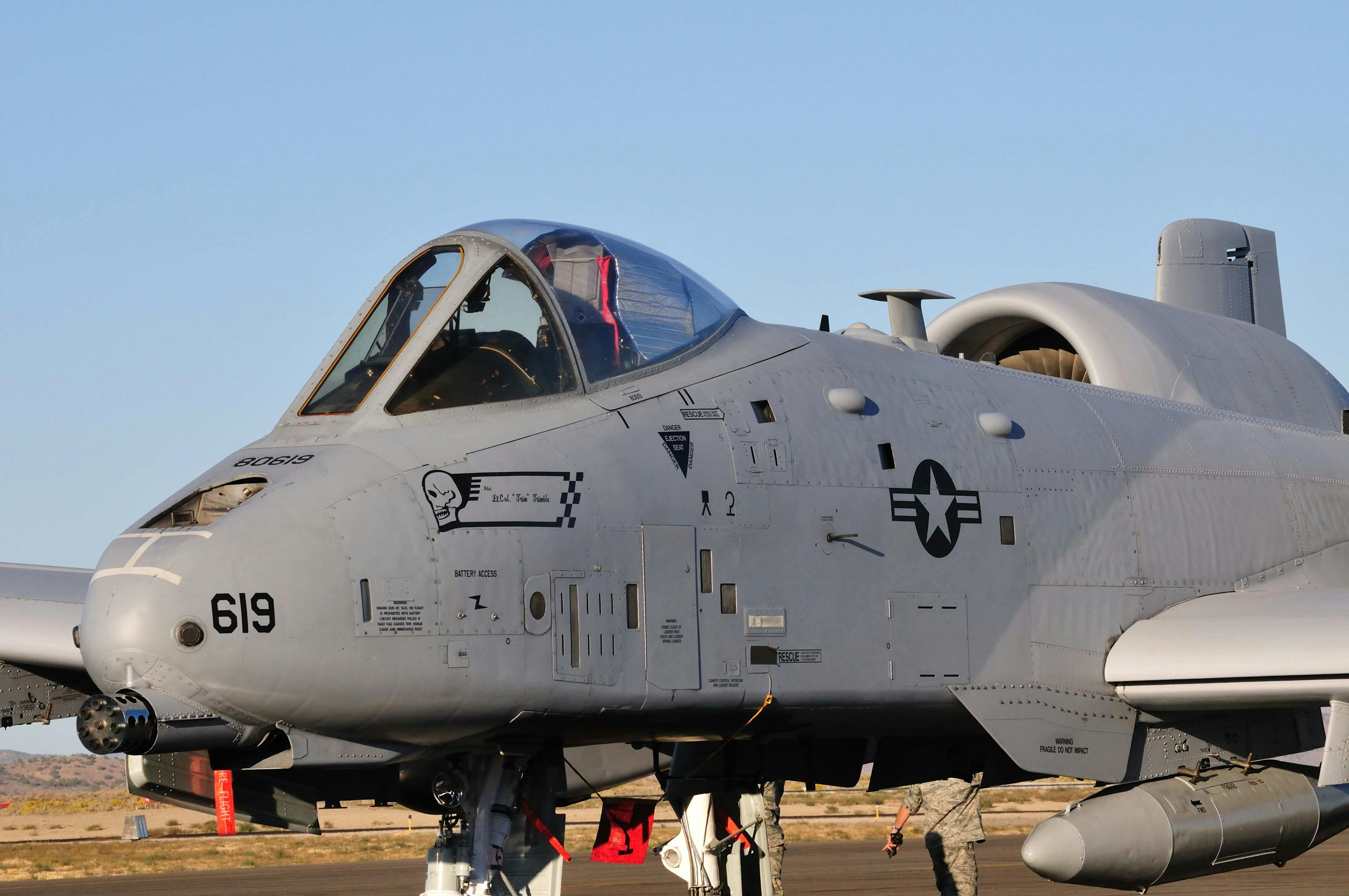A-10 go BRRRT: Why the Warthog is still king of the tank-killers

Blog
It’s difficult to think of a more famous, iconic combat aircraft than the Fairchild Republic A-10 Thunderbolt II, commonly known as the Warthog. The close-air support (CAS) and attack fighter has earned fanatical support from pilots, crew, and the infantry who have been protected by the A-10’s monster GAU-8/A Avenger 30mm rotary cannon or other combat-effective armament. This popularity has skyrocketed in recent decades due to the A-10’s appearance in popular combat video games (such as the Battlefield, Ace Combat, War Thunder, and Call of Duty series as well as several dedicated flight simulators) beginning around 1989. The A-10 has even spawned several memes based on its distinctive sound when firing its cannon (something along the lines of “hehehe A-10 go BRRRT”).
The A-10 has been widely used not only in the CAS role, but also in Combat Search And Rescue (CSAR) missions, as well as an airborne forward air control platform. But the United States Air Force aims to judge its assets by their capabilities, rather than nostalgia or popularity with airmen (or gamers), and has attempted several times to retire the A-10 fleet in favor of newer, shinier, supposedly superior aircraft like the F-35 Lightning II.
In this article we’re going to discuss what makes the A-10 so effective, so unique, and ultimately, so difficult to replace.

Development of the A-10
The Close Air Support aircraft concept really originated during WWII, but reached its true potential during the Vietnam conflict. The intent behind close air support is to provide firepower in offensive and defensive operations, day or night, and to destroy, suppress, neutralize, disrupt, fix, or delay enemy forces in close proximity to friendly ground forces.
The Douglas A-1 Skyraider gained great fame during Vietnam and was deployed into the 1980s, but a more capable, jet-powered CAS aircraft was needed. The Skyraider, designed during WWII, was capable aircraft for its era, having a relatively large bomb/rocket payload and lengthy loiter time, but its propeller-driven engine made it comparatively slow and vulnerable to ground fire. Its armament was also deemed inadequate. The USAF and Navy lost 266 A-1s in action in Vietnam, mostly due to small-arms fire from the ground.
Around 1961, Defense Secretary McNamara ordered the USAF to develop specialized attack aircraft, eventually resulting in the F-111 Aardvark and the F-4 Phantom. Both aircraft excelled in their own spheres, but were certainly not suitable for a CAS role. During the early ‘60s, the attack helicopter began to be a thing, and the Bell AH-1 Cobra met with good success in Vietnam, up to a point. Range was still short, armament relatively light, and it wasn’t good at the escort role. In 1966, a USAF study determined that “the service should acquire a simple, inexpensive, dedicated CAS aircraft at least as capable as the A-1, and that it should develop doctrine, tactics, and procedures for such aircraft to accomplish the missions for which the attack helicopters were provided.”
By May 1970, the threat of Soviet tanks and the need for all-weather-capable CAS aircraft was more urgent, and the USAF issued a modified request for proposals (RFP) for the A-X (Attack Experimental) aircraft, which would need to be designed specifically to utilize a new, 30mm rotary cannon. The RFP also required a maximum speed of 460 mph (740 kph), a takeoff distance of 4,000 feet (1,200 m), an external armament load of 16,000 pounds (7,300 kg), a 285-mile (460 km) mission radius, and a unit cost of $1.4 million. The A-X would be the first USAF aircraft designed exclusively for the CAS role. Since the required 30mm rotary cannon didn’t exist, at the same time a separate RFP was issued for the A-Xs cannon, eventually being built by General Electric (more on this below).
Six companies submitted proposals, with Northrop’s YA-9A and Fairchild’s YA-10A being selected as prototypes for construction and flight competition. In January 1973, the USAF announced Fairchild’s design as the winner. Before full production was green-lit, the YA-10A also had to prove its mettle in a fly-off with the Vought A-7D Corsair II, which was the closest thing to a dedicated ground-attack aircraft at the time.
The value of the A-10 was proved, and the first Thunderbolt IIs were delivered to the USAF in March 1976. A total of 713 aircraft were built through 1984. That means the newest A-10 in service is almost 50 years old. This raises some issues, as we’ll see later. But first, let’s look at what makes the A-10 so effective at its CAS and anti-tank role.

To kill a tank, first make a tank that flies
It may seem a little cliche, but the A-10 is literally a flying tank. The A-10 carries a 1,200 lb (540 kg) titanium alloy “bathtub” of armor up to 1.5 inches thick (38 mm) that protects the pilot and cockpit, and is one of the first major uses of this advanced metal in aerospace. The Warthog was designed to survive direct hits from armor-piercing and high explosive projectiles up to 23mm in diameter, indirect fragments from 57mm anti-aircraft shells, and has survived worse.
In addition to its formidable armor, the A-10 is extremely durable and resistant to enemy fire due to its self-sealing fuel cells, which are protected by internal and external foam. Double-redundant hydraulic flight-control systems are backed up by manual control mechanisms, so A-10 pilots can fly and land safely even if all hydraulic pressure is lost.
The A-10 Thunderbolt II can be serviced and operated from bases with limited facilities near battle areas, and from unimproved and non-traditional runway surfaces. It was also given two, high-mounted, easily serviceable engines, and can fly on only one.
Additionally, the Warthog’s somewhat ugly, bulky-looking design is absolutely intentional. Many of its major component parts are “ambidextrous” so to speak… meaning that they are symmetrical from side to side and may be installed and used on either the left or the right half of the airplane. This includes the engines, main landing gear, vertical stabilizers, and some other parts. If you were designing an attack aircraft to take the most advantage of economy of maintenance and components, the A-10 would be close to the ideal.
Big gun in a little plane
The A-10 is most famous for, and literally exists because of, its GE 30mm 7-barrel “gatling” gun, capable of firing armor-piercing and high-explosive incendiary rounds at over 3,900 rounds per minute. With a typical loadout of 1,150 rounds in its drum, that means an A-10 fires 65 rounds per second, and the pilot has just over 17.5 seconds of BRRRT available to solve all his/her problems before needing to fly back to base and rearm the cannon. The gun is capable of firing an entire magazine full of ammunition in one burst, but the heat buildup is hard on the barrels, which are a tad spendy. So pilots typically restrict themselves to bursts (or BRRRSTs, heh) of between 1 and 3 seconds. And if 200 rounds of depleted uranium, armor-piercing and high-explosive/incendiary rounds hitting your target in 3 seconds won’t solve your problem, there’s not much that will.
Some initial trial aircraft had the barrels mounted down the central axis of the aircraft, but the cannon fires from the right/starboard side barrel (around 9 o’clock when looking down the muzzles) and this was deemed to make the aircraft somewhat unstable, so the gun was moved to the left a little, with the firing barrel aligned down the centerline. The front landing gear is offset to allow space for the cannon.
Incidentally, the USAF began considering replacing its depleted uranium penetrators with lighter–and slightly friendlier–tungsten-core projectiles around 2018. TWZ says, “The Air Force looks to be taking the opportunity to see whether it makes fiscal sense, if nothing else, to abandon DU in favor of tungsten. It could be an easy public relations victory, but depending on how much more expensive the latter metal is, it might not make sense in the context of purchasing hundreds of thousands of rounds of ammunition. Tungsten is also less dense than DU and may be less effective in penetrating armor. Though less politically charged, a new version of the PGU-14 [A-10 penetrator round] could limit the effectiveness of the A-10’s main gun. It could also force pilots to make more gun runs against particular targets to ensure they are destroyed, potentially reducing the total number of targets each aircraft could engage per sortie.”
The official specs say the effective range of the Avenger cannon is 1,200 meters (4,000 feet) with a maximum range of 3,660 m (12,000 feet), but some sources say the A-10 can destroy a tank (if it can hit it) from 6,500 meters (21,300 feet). Maybe if it’s flying straight down, we’re guessing.
Regardless, even if the A-10’s fearsome and famous cannon runs dry, the aircraft still has a formidable array of additional armament available, which is objectively more effective at killing more armor, vehicles, and ground forces. Updated A-10Cs can carry up to 16,000 pounds (7,200 kilograms) of mixed ordnance on eight under-wing and three under-fuselage pylon stations, including 500 pound (225 kg) Mk-82 or 2,000 pound (900 kg) Mk-84 series low/high drag bombs, the new GBU-39 Small Diameter Bombs, laser-/GPS-guided bombs and JDAMs (Joint Direct Attack Munition precision guided bombs), incendiary cluster bombs, combined effects munitions, mine dispensing munitions, AGM-65 Maverick missiles, unguided and laser-guided 2.75-inch (6.99 cm) rockets, infrared countermeasure flares, electronic countermeasure chaff, jammer pods, illumination flares, and AIM-9 Sidewinder missiles. Probably a partridge in a pear tree, as well.
In fact, during the Gulf War, A-10s fired 90% of the AGM-65 Maverick air-to-ground missiles used during the conflict.

How much does an A-10 Thunderbolt II (Warthog) cost?
The original A-10 procurement documentation for the Air Force specified a design-to-cost goal of $15 million per unit flyaway cost, based on a production quantity of 600 aircraft, expressed in fiscal year 1970 dollars. In today’s Monopoly money, that’s equal to around $120 million per aircraft.
By the time the A-10 began rolling off the production line in earnest in 1976, the per-unit cost was around $18 million per aircraft. According to the Air Force’s fact sheet, unit cost was $9.8 million in 1998 constant dollars, which we expect was the last time their website was updated. That figure doesn’t jibe with other sources though, so we’re guessing the $9.8 million figure maybe didn’t include things like, you know, engines or avionics or spare parts. Maybe landing gear. Or ammo.
However, it’s difficult to place a current, relevant price on the A-10 today, since the last one of the 713 total A-10s produced left the production line in 1984. And, there have been multiple, significant upgrades and refits since then, some of which equal or approach the original per-unit cost in adjusted dollars. The new wings alone average around $6.4-$7 million per set (see below), and as far as we can determine, all of the Air Force’s roughly 282 flying A-10s have been upgraded with new wings. Speaking of which…
Well, there’s yer problem! Your Warthog’s wings are cracked
Shortly after the A-10 entered service, fatigue cracks where the wings joined the fuselage were noted, and interim remedies were used to bring them up to the then-standard 8,000 hours of service life. In actual use, stress fractures proliferated far more quickly than was anticipated. Around 1979, thicker wing panels were specified and the design was updated somewhat to help alleviate these fractures. Internal spars of the wings were modified to accommodate thicker skin. These rather patchwork updates continued until around 1987, when Grumman Aerospace took over the maintenance and any necessary redesign of the A-10 fleet. Air Force bases were being closed and workforces laid off, and the USAF as well as Grumman (not to mention Congress) was anxious to make the fleet safe and durable for as little money as possible.
By 1996s the wing cracks were deemed to be critical, which meant that they could no longer be repaired, but rather needed replacement. After a lot of hemming and hawing the solution was to award Boeing a $1.72 billion contract in 2005 to build upgraded wings for the A-10 fleet.
The upgraded A-10C: a Warthog for the 21st century
In addition to the new wings, from 2005 to June 2011, the US’s entire fleet of A-10s were modernized and redesignated the A-10C. Improvements included all-weather combat capability, an improved fire-control system, electronic countermeasures, “smart” bomb targeting, a modern communications suite including a Link 16 radio and Satcom, and multiple avionics updates. Pilots also benefited from an improved helmet targeting system.
Air Force Times reports, “AFMC said that upgrading the four-decade-old aircraft proved tricky at times. The Air Force had to pull spare A-10 parts up from the 309th Aerospace Maintenance and Regeneration Group at Davis-Monthan Air Force Base in Arizona, also known as the Boneyard. New parts for the plane’s fuselage also had to be created.”
Rumors of the A-10’s demise have been greatly exaggerated
Despite these upgrades, in 2014, the USAF informed congress that the A-10 Thunderbolt II was outdated and inadequate for surviving modern battlefields. The Air Force recommended that the Warthog be retired to free up personnel, resources, and $4.2 billion in funding that could then be dedicated to the F-35 Lightning II, which the USAF intended as the A-10’s replacement. Congress insisted that the Air Force prove its case, demanding trials between the F-35 and the A-10 to showcase the latter’s supposed shortcomings. However, to make things as equitable as possible, the A-10 was to undergo a thorough refresh. Since the two fighters were designed 30+ years apart and really have different designs and philosophies of use, it still wouldn’t really be an apples-to-apples comparison, but that’s kinda the point. The A-10 is so good at what it does that any replacement aircraft would have to be pretty similar.
Improvements made during this update included communications systems, improved standoff weapons, faster loading rockets, night vision systems, and a situational awareness pad in the cockpit, allowing controllers to more easily see all combatants and aircraft instantly in a digital format. As recently as 2023, A-10 pilots have started wearing an improved helmet mounted sight, known as HObIT (Hybrid Optical-based Inertial Tracker), which allows separate targeting and attack of 6 (some sources say up to 18) separate targets independently, with one push of the button.
Thunderbolts or Lightnings, very very frightening
The planned flyoff between the A-10 and F-35 got a lot of buzz at the time, but was shrouded in secrecy, and in the end it sort of fizzled out. The F-35’s greatly superior stealth capabilities in air-to-air missions is inarguable, but those sharp angles and stealth features that require computer-aided control surfaces also make the aircraft inferior to the more “analog” A-10 when it comes to loitering over a specific area in the battlefield or low-level CAS and CSAR missions. The Warthog is inarguably more resistant to ground fire. There’s also the issue of the eye-wateringly high cost of the F-35 at around $135 million per copy. And, let’s face it… the F-35’s 182 rounds of 25mm ammo just doesn’t give you the same amount of BRRRT as the A-10.
So, while it may be a 50-year-old thorn in the USAF’s side, the Warthog is still kicking ass and taking names today, and looks to continue doing so until at least the 2030s.
–By Jeff Davis, Intergalactic Scribe
Sources:
https://en.wikipedia.org/wiki/Fairchild_Republic_A-10_Thunderbolt_II
https://youtu.be/DENooT2Y34k?si=Ebi_2fU3q_PL9PU_